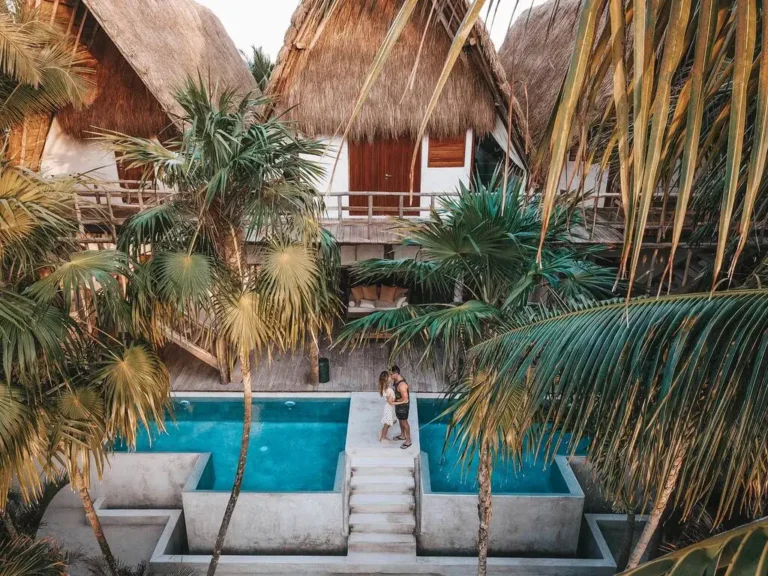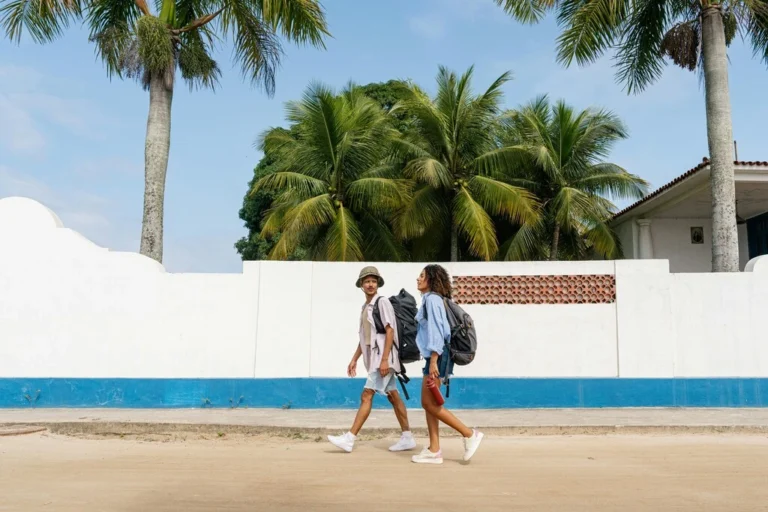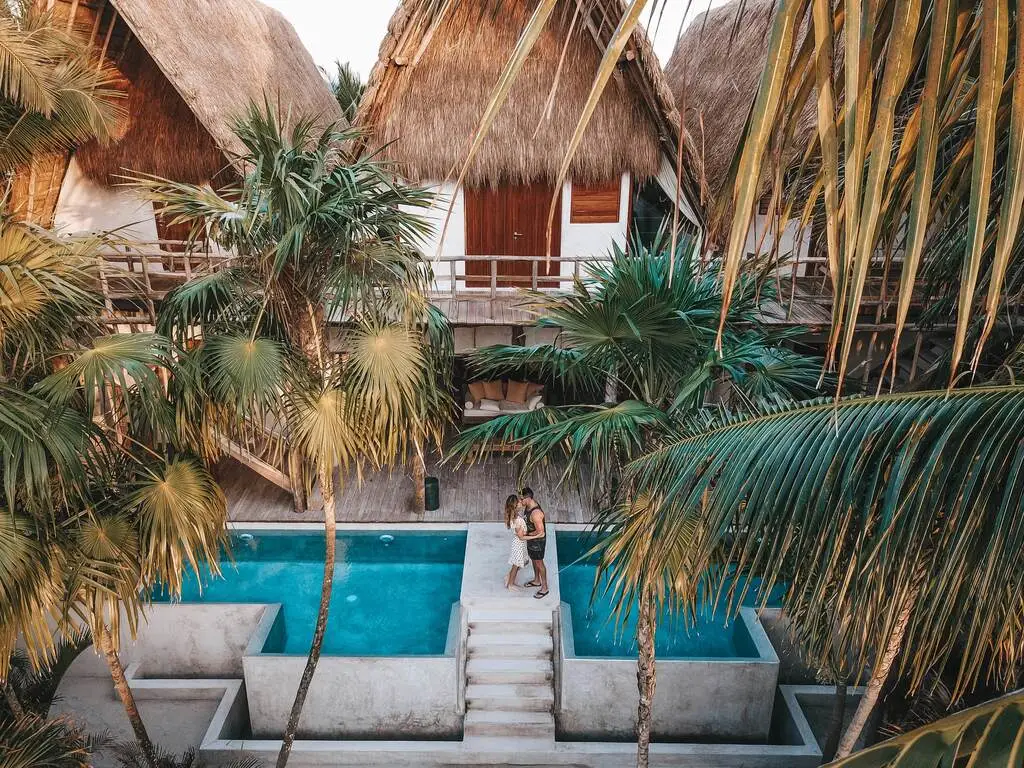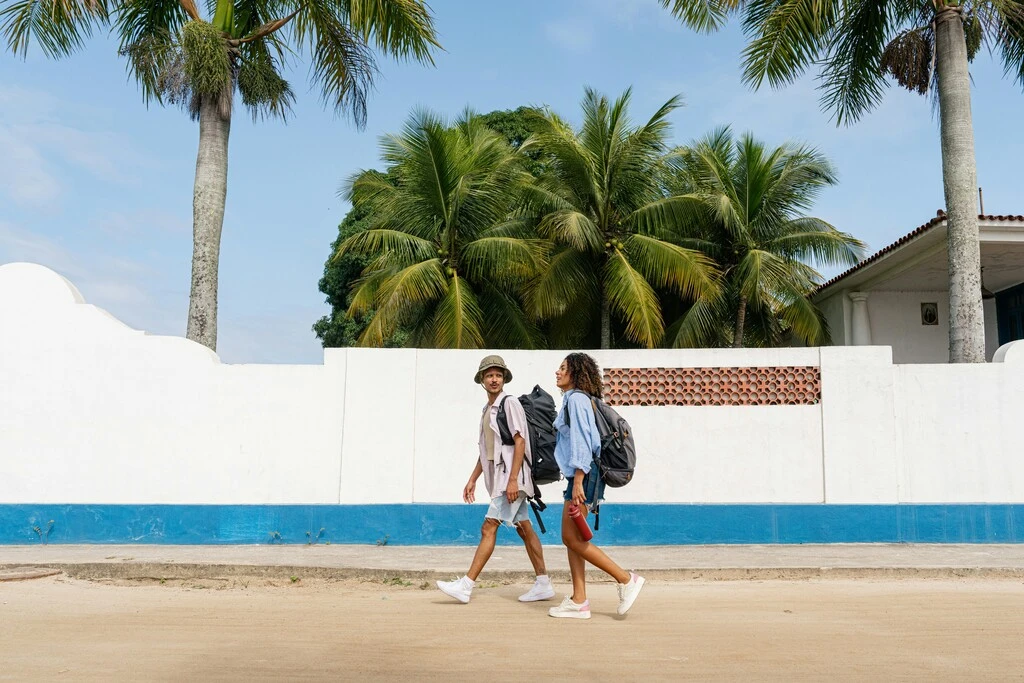Around 7,000 elephants live in Thailand, with half of them in captivity. Sadly, exploitation for tourism is still common. Elephant rides are offered, the animals have to perform tricks, and they are chained with iron chains for their entire lives.
While looking for an ethical elephant place, we found the Koh Phangan Elephant Sanctuary. So far, we have visited it three times as a family.
But how ethical is the Koh Phangan Elephant Sanctuary? What can you expect from the different programs? And is it suitable for families with young children? You’ll find all the answers in this article – my personal and honest review!
The History of the Koh Phangan Elephant Sanctuary
Phangan Elephant Sanctuary is home to three lovely old ladies (ranging from 43 to 67 years), all rescued from elephant riding camps in Pattaya. These wise, gentle females spent years carrying heavy loads and giving rides to tourists. Now, they finally get to enjoy a well-deserved retirement!
The sanctuary started as a dream of a Thai man in 2019, with the goal of giving elephants freedom and protection. After a rough start, including a break during COVID, it has finally opened its doors. It’s tucked away in the lush hills of Baan Madue Wan.
The focus here is simple: letting elephants be elephants—no rides, no forced baths, just lots of mud baths, snacks, and love.
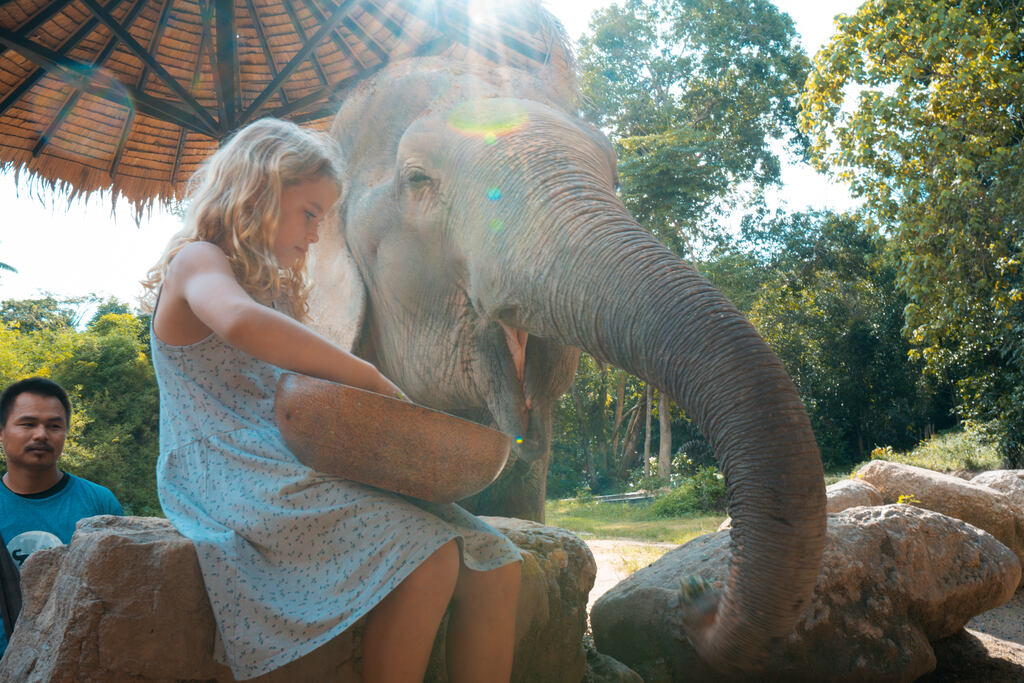
Visitor Programs: What to Expect at Koh Phangan Elephant Sanctuary
Phangan Elephant Sanctuary offers visitors two types of experiences: the Tour Program and the Feeding Program.
Tour Program
The Tour Program lasts about two hours and includes several activities. It starts with a registration, followed by a short and pretty funny video that explains the sanctuary’s mission. After that, you get to prepare rice balls and feed the elephants a mix of fruits. This hands-on feeding experience lets you get close to the elephants and see their personalities up close.
After feeding, there’s a walk through the sanctuary. You’ll watch the elephants in a more natural environment, learn about their behavior, and hear stories from the guides. You’ll also get an introduction to the herbal medicines used to support the elephants’ health. The program ends with a snack and a soft drink for the guests.
Feeding Program
The Feeding Program is shorter, lasting about an hour, and focuses mainly on feeding the elephants. We did this program with our girls (ages 2 and 6), and it was just right for them. It was long enough to enjoy time with the elephants but not so long that they got bored.
You’ll help prepare rice balls and feed a mix of fruits to the elephants. Then, you’ll take a walk to the other side of the sanctuary, where you’ll learn about the anatomy of elephants and the cruel reality of riding practices. There’s a real 60 kg elephant riding saddle and a device used by non-ethical elephant camps to control them.
The guides speak good English and share insights about the sanctuary’s work and the stories of the elephants (which are mostly really sad!).
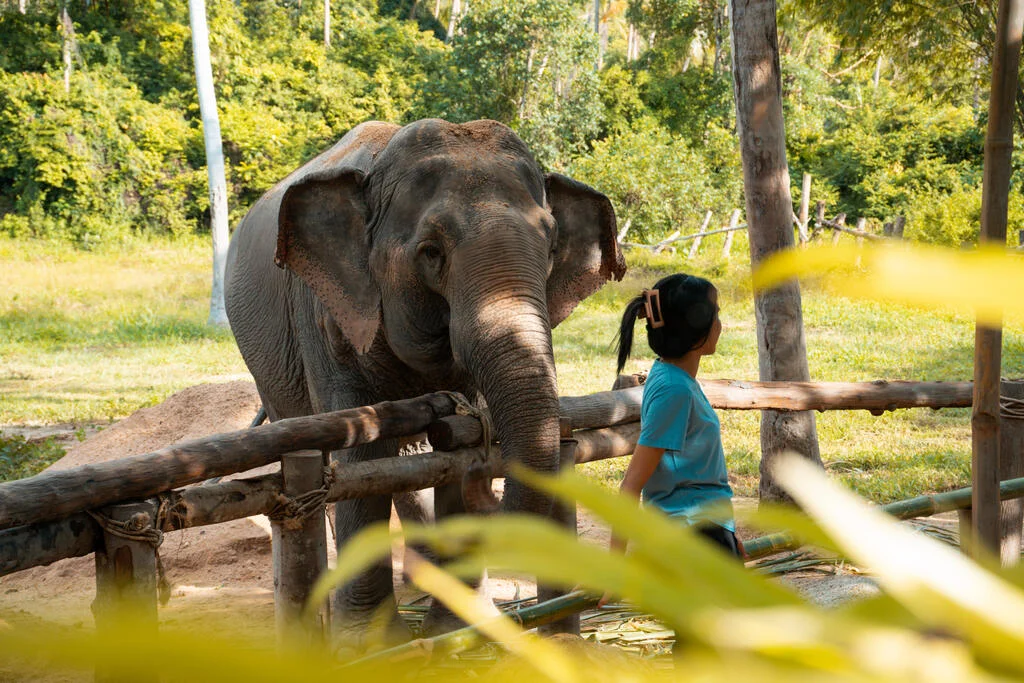
Ethical Considerations
If you’ve been following my blog for a while, you know I don’t recommend activities or places where animals are exploited. For the past 20 years, we haven’t visited zoos, circuses with animals, or similar places. So, I’m very cautious when it comes to visiting places with animals.
Many elephant camps in Thailand don’t allow riding, but the elephants are still washed by tourists several times a day. I don’t consider that ethical either. In my view, animals shouldn’t be touched excessively or forced to stand still for photos or other unnecessary activities.
That’s why I really appreciate the approach at the Koh Phangan Elephant Sanctuary. The elephants are only touched during feeding, and they aren’t forced to stay still or pose for photos.
In fact, the only time tourists can stand next to them for a photo is when the elephants are busy eating a big basket of fruit. Once the elephant is done or simply not interested anymore, it just walks away.
I love this approach. It’s exactly the kind of respect that elephants and all animals deserve.
Here’s why the Koh Phangan Elephant Sanctuary is considered ethical:
- No Riding: The sanctuary strictly prohibits riding, which can damage the elephants’ spines and cause long-term health problems. Instead, interactions focus on feeding, walking, and observing the elephants in their natural behavior.
- Free-Roaming Environment: The elephants can roam freely around the sanctuary without chains. This environment allows them to behave naturally—bathing in mud, foraging, and socializing with other elephants.
- Focus on Rehabilitation: The sanctuary only shelters rescued elephants from the tourism and logging industries. It offers them a safe, stress-free place where they can heal from past traumas and live peacefully.
- Education and Awareness: Visitors learn about the elephants’ history, behavior, and health needs. This helps raise awareness about the challenges of captive elephants and the importance of supporting ethical tourism.
- Natural Care: The sanctuary uses natural healing herbs as part of its healthcare for the elephants.
Costs and Booking Information for Koh Phangan Elephant Sanctuary
You must book your visit online in advance. Visit this page to book your appointment.
The sanctuary doesn’t accept online payments, so be sure to bring cash for entry. If you have a Thai bank account, you can also pay via QR code.
Tour Program
- Adults: 2,500 THB
- Children (4-11 years): 1,500 THB
- Children under 4: Free
- Schedule: The Tour Program is available in the morning (9:30-11:30) and the afternoon (14:00-16:00).
Feeding Program
- Adults: 1,000 THB
- Children (4-11 years): 500 THB
- Children under 4: Free
- Schedule: The Feeding Program runs at multiple times throughout the day: morning (11:00) and afternoon (13:00, 15:30, and 16:00).
Tips for Visiting
- Since only a part of the sanctuary is covered, you might get wet if it rains. But the sanctuary provides large umbrellas. Wear a hat or cap to protect yourself from the sun.
- I recommend wearing plastic slippers. You’ll be walking through the elephants’ habitat, and it can get muddy after rain. It’s handy to have shoes you can easily rinse off afterward.
- Make sure to apply enough mosquito spray before you go. I’ve noticed that mosquitoes tend to be more aggressive in areas with animals.
- Arrive 10 minutes before the tour starts. This gives you time to pay and grab a quick drink of water.
- Water and other drinks are available on-site, so you don’t need to pack much.
- We found the smallest groups during weekday afternoons. Weekends are usually quite busy, and weekday mornings sometimes have school groups.
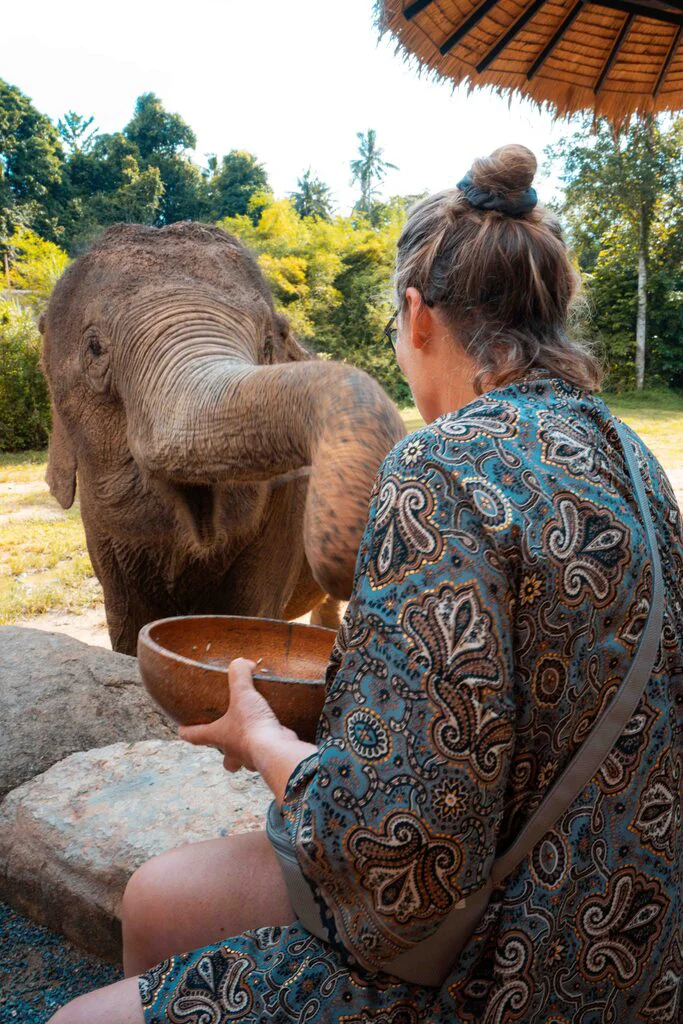
Is the Koh Phangan Elephant Sanctuary Family-Friendly?
Our youngest was 2 years old when we first visited. She comfortably lasted through the one-hour Feeding Program and had a lot of fun. Older children can, of course, get even more out of the visit, as they can understand and learn more.
It’s important that kids don’t run around wildly or shout. They should stay in front of or beside the elephant (never behind it) and remain with the group.
The sanctuary’s facilities are modern and safe. Since you’re not allowed to move around the elephants alone or unsupervised, I find the whole experience very safe.
There is one elephant who was sadly abused at a riding camp in Pattaya. He is so traumatized that you’re not allowed to interact with him. However, you can watch him being fed by a team member. I think this is a fair and safe approach, both for the elephant and the visitors.
Final Thoughts on Visiting Koh Phangan Elephant Sanctuary
In summary, visiting the Koh Phangan Elephant Sanctuary is a one-of-a-kind chance to see elephants living freely and naturally, without any forced interactions. What makes this place different is its ethical approach—no riding, minimal touching, and a real focus on rehabilitation.
It’s also a fantastic learning experience for kids, helping them understand why animal welfare matters, all while safely meeting these gentle giants.
If you’re looking for an ethical way to interact with elephants in Thailand, this sanctuary is totally worth it! Just remember to book ahead, bring cash, and dress for the weather to make the most of your visit!
Check out what else to do in Koh Phangan with kids!
Have you been to the Koh Phangan Elephant Sanctuary? How was your experience? I’d love to hear your thoughts in the comments!
Thanks for reading and for making me part of your day! Yours, Lulu
FAQ on the Koh Phangan Elephant Sanctuary
How does the Koh Phangan Elephant Sanctuary differ from other sanctuaries like the Samui or Phuket Elephant Sanctuary?
Koh Phangan Elephant Sanctuary focuses on creating a stress-free environment for the rescue elephants by promoting minimal human interaction and encouraging their natural behaviors. While other sanctuaries, like the Samui Elephant Sanctuary or the Phuket Elephant Sanctuary, share similar principles, each sanctuary varies in its programs, location, and overall setup. The aim across all these places is consistent: to provide a safe retirement home for elephants rescued from the tourism industry and illegal logging.
Is it possible to see a baby elephant at the sanctuary?
No, the Koh Phangan Elephant Sanctuary is home to older elephants that have been rescued, so you won’t find a baby elephant here (even though maybe one of the elephants is pregnant. As of October 2024, the staff is still waiting for a doctor from Bangkok to confirm this). If you are hoping to experience young elephants in a similar ethical setting, you might want to consider a visit to the Elephant Nature Park in Chiang Mai.
What are the main reasons for supporting ethical elephant sanctuaries?
Supporting ethical elephant tourism helps protect these magnificent creatures from harmful practices such as riding, performing tricks, or living in inadequate space. The establishment of such sanctuaries aims to provide rehabilitation for elephants while promoting responsible tourism and raising awareness about animal welfare concerns.
What is the best way to reach Koh Phangan Elephant Sanctuary?
Most visitors arrive via Ko Samui or southern Thailand, taking a ferry to Koh Phangan. You can book a shuttle service that includes an air-conditioned vehicle for convenient transportation to the sanctuary. Transfers from specific locations on the island, like Tong Nai Pan or Haad Yao, are available for an additional fee.
Is there an option for an overnight stay at the sanctuary?
Currently, Koh Phangan Elephant Sanctuary does not offer an overnight stay option. Their programs are typically half-day experiences that are 1-2 hours long, either morning or afternoon programs.
What safety measures are in place for visitors?
The sanctuary maintains strict safety protocols for both guests and elephants. Visitors are always accompanied by staff members and must follow guidelines, such as not approaching elephants from behind. This ensures an enjoyable experience while keeping the majestic animals safe and comfortable.
Is the Koh Phangan Elephant Sanctuary suitable for visitors of all ages?
Yes, it’s an unforgettable experience for animal lovers, including families with young children. Programs are designed to be educational and family-friendly, providing insights into the natural needs of elephants. Children must be supervised, and all visitors are encouraged to show respect and avoid loud noises to maintain a calm environment for the elephants. We’ve also visited the Koh Phangan Elephant Sanctuary with my parents who are between 62 and 70 years old. They had so much fun!
Are there any facilities or amenities on-site at Koh Phangan Elephant Sanctuary?
Yes, the sanctuary offers basic amenities, including restrooms, a small gift shop, and refreshments. You’ll find cold drinks and snacks available.
How do entrance fees contribute to the sanctuary’s mission?
The entrance fees directly fund the care of the elephants, including their medical needs, food, and the maintenance of the sanctuary’s grounds. These fees also support local communities by providing employment opportunities in ethical tourism.
How do the sanctuary’s conservation efforts impact the future of ethical elephant treatment in Southeast Asia?
By supporting ethical sanctuaries like Koh Phangan Elephant Sanctuary, visitors help drive a shift towards responsible tourism. The sanctuary’s work aligns with broader goals for the conservation of elephants in Southeast Asia, helping to protect these endangered species and promote the establishment of more reputable sanctuaries.
Are there other ethical programs in Thailand similar to Koh Phangan Elephant Sanctuary?
Yes, Thailand is home to several reputable sanctuaries, including Elephant Hills in Khao Phra Thaeo National Park, and Phang Nga Elephant Park. Each focuses on ethical treatment, rehabilitation, and offering a natural environment for elephants.
Just a heads up: some links in the article “Koh Phangan Elephant Sanctuary” on Nomadmum.com are affiliate links. This means if you click and buy, I might earn a small commission at no extra cost to you.


